weight TOYOTA HIGHLANDER HYBRID 2020 Warranties & Maintenance Guides (in English)
[x] Cancel search | Manufacturer: TOYOTA, Model Year: 2020, Model line: HIGHLANDER HYBRID, Model: TOYOTA HIGHLANDER HYBRID 2020Pages: 260, PDF Size: 8.54 MB
Page 19 of 260
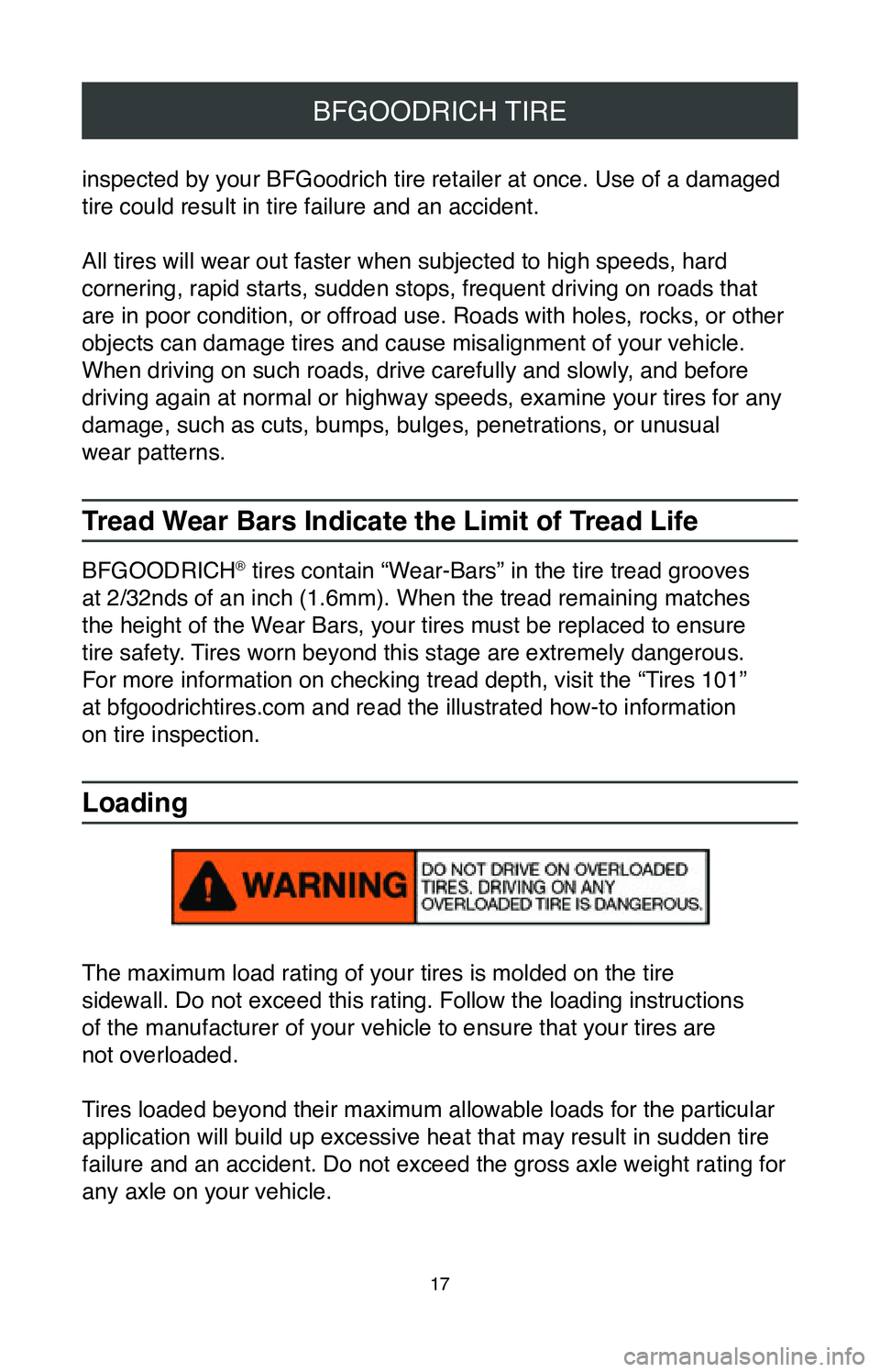
17
BFGOODRICH TIRE
inspected by your BFGoodrich tire retailer at once. Use of a damaged
tire could result in tire failure and an accident.
All tires will wear out faster when subjected to high speeds, hard
cornering, rapid starts, sudden stops, frequent driving on roads that
are in poor condition, or offroad use. Roads with holes, rocks, or other
objects can damage tires and cause misalignment of your vehicle.
When driving on such roads, drive carefully and slowly, and before
driving again at normal or highway speeds, examine your tires for any
damage, such as cuts, bumps, bulges, penetrations, or unusual
wear patterns.
Tread Wear Bars Indicate the Limit of Tread Life
BFGOODRICH® tires contain “Wear-Bars” in the tire tread grooves
at 2/32nds of an inch (1.6mm). When the tread remaining matches
the height of the Wear Bars, your tires must be replaced to ensure
tire safety. Tires worn beyond this stage are extremely dangerous.
For more information on checking tread depth, visit the “Tires 101”
at bfgoodrichtires.com and read the illustrated how-to information
on tire inspection.
Loading
The maximum load rating of your tires is molded on the tire
sidewall. Do not exceed this rating. Follow the loading instructions
of the manufacturer of your vehicle to ensure that your tires are
not overloaded.
Tires loaded beyond their maximum allowable loads for the particular
application will build up excessive heat that may result in sudden tire \
failure and an accident. Do not exceed the gross axle weight rating for \
any axle on your vehicle.
Page 23 of 260
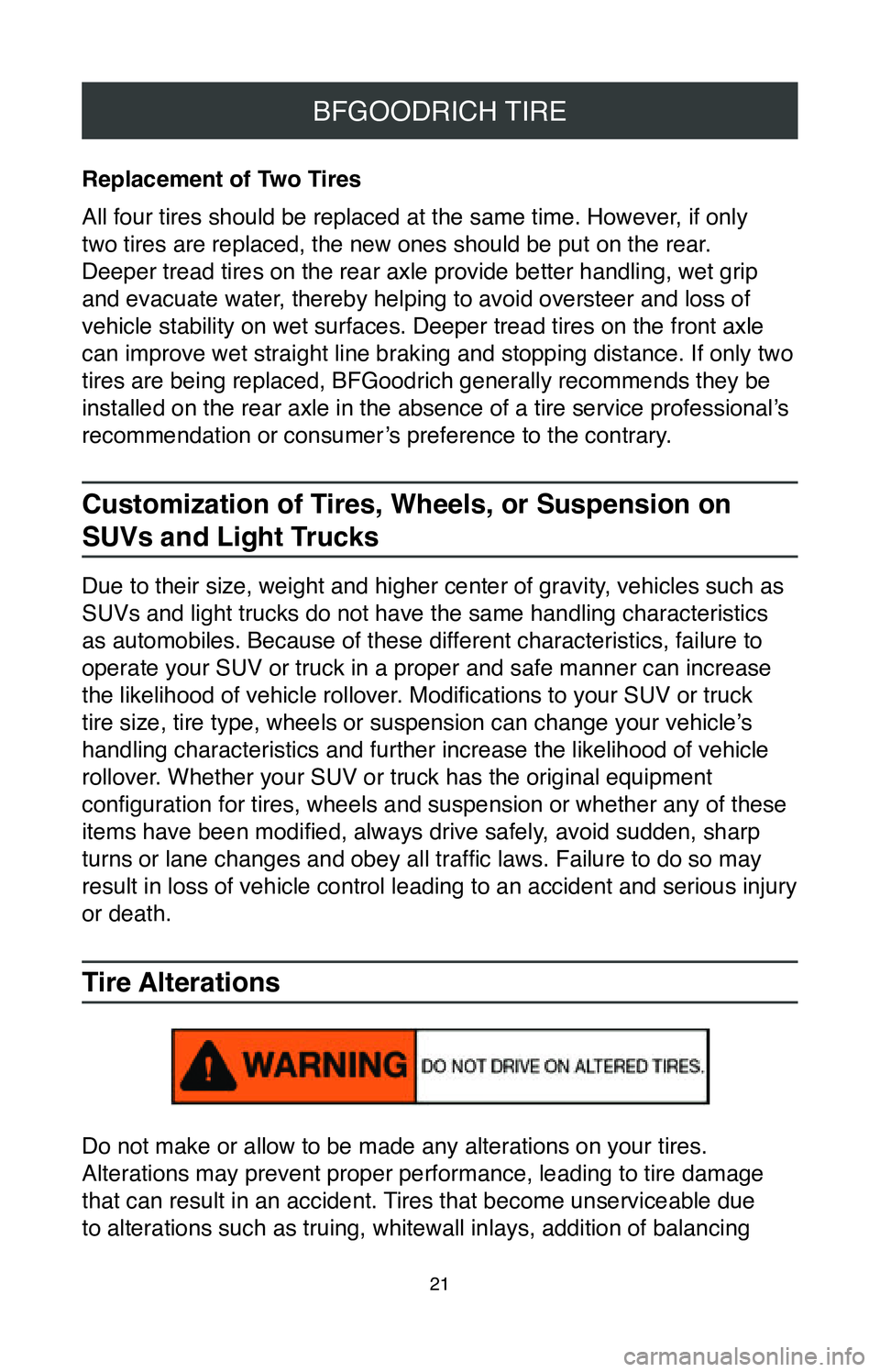
21
BFGOODRICH TIRE
Replacement of Two Tires
All four tires should be replaced at the same time. However, if only
two tires are replaced, the new ones should be put on the rear.
Deeper tread tires on the rear axle provide better handling, wet grip
and evacuate water, thereby helping to avoid oversteer and loss of
vehicle stability on wet surfaces. Deeper tread tires on the front axle \
can improve wet straight line braking and stopping distance. If only two\
tires are being replaced, BFGoodrich generally recommends they be
installed on the rear axle in the absence of a tire service professional’s
recommendation or consumer’s preference to the contrary.
Customization of Tires, Wheels, or Suspension on
SUVs and Light Trucks
Due to their size, weight and higher center of gravity, vehicles such as
SUVs and light trucks do not have the same handling characteristics
as automobiles. Because of these different characteristics, failure to
operate your SUV or truck in a proper and safe manner can increase
the likelihood of vehicle rollover. Modifications to your SUV or truck
tire size, tire type, wheels or suspension can change your vehicle’ s
handling characteristics and further increase the likelihood of vehicle \
rollover. Whether your SUV or truck has the original equipment
configuration for tires, wheels and suspension or whether any of these
items have been modified, always drive safely, avoid sudden, sharp
turns or lane changes and obey all traffic laws. Failure to do so may
result in loss of vehicle control leading to an accident and serious injury
or death.
Tire Alterations
Do not make or allow to be made any alterations on your tires.
Alterations may prevent proper performance, leading to tire damage
that can result in an accident. Tires that become unserviceable due
to alterations such as truing, whitewall inlays, addition of balancing
Page 25 of 260
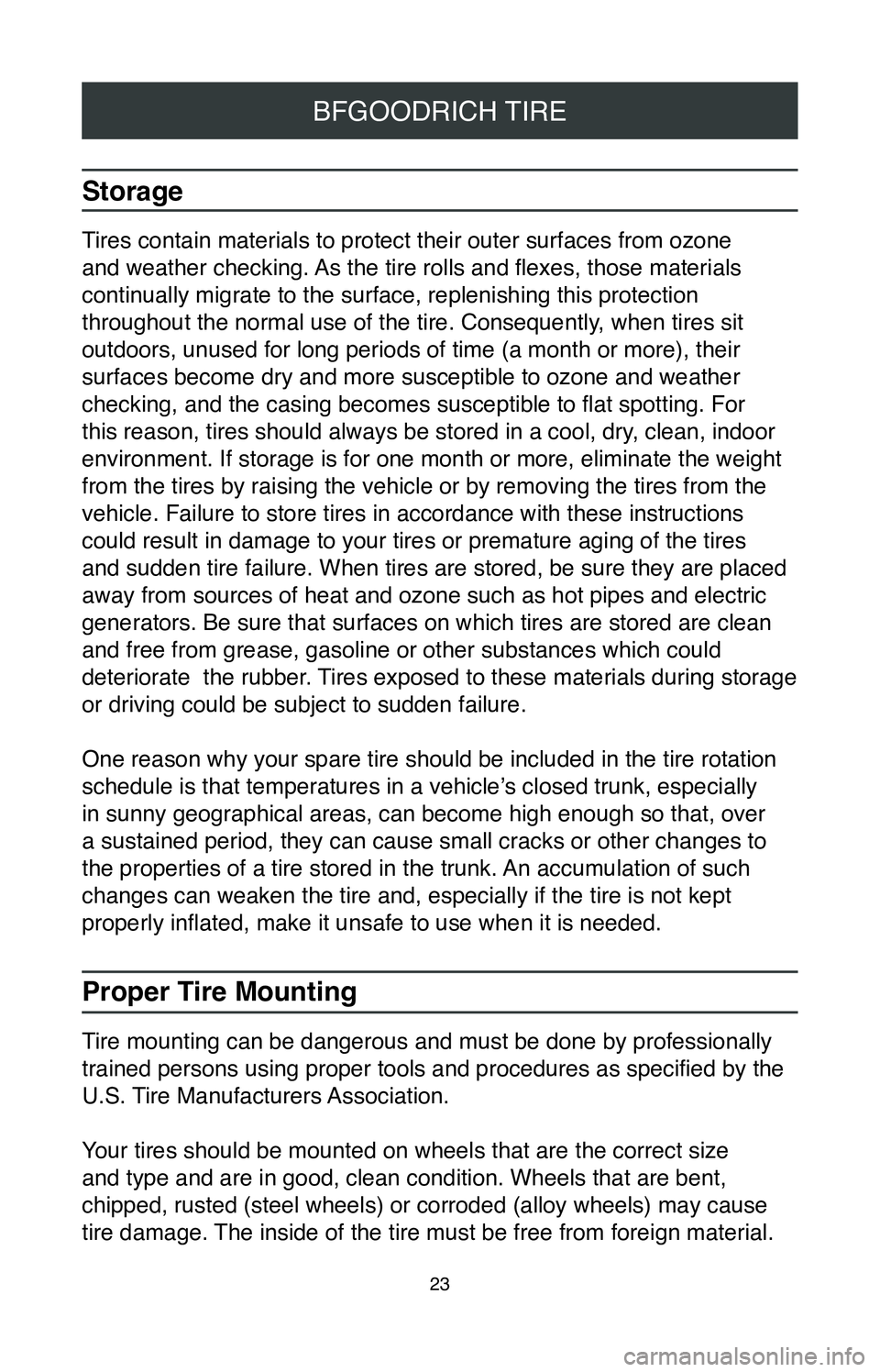
23
BFGOODRICH TIRE
Storage
Tires contain materials to protect their outer surfaces from ozone
and weather checking. As the tire rolls and flexes, those materials
continually migrate to the surface, replenishing this protection
throughout the normal use of the tire. Consequently, when tires sit
outdoors, unused for long periods of time (a month or more), their
surfaces become dry and more susceptible to ozone and weather
checking, and the casing becomes susceptible to flat spotting. For
this reason, tires should always be stored in a cool, dry, clean, indoor
environment. If storage is for one month or more, eliminate the weight
from the tires by raising the vehicle or by removing the tires from the \
vehicle. Failure to store tires in accordance with these instructions
could result in damage to your tires or premature aging of the tires
and sudden tire failure. When tires are stored, be sure they are placed \
away from sources of heat and ozone such as hot pipes and electric
generators. Be sure that surfaces on which tires are stored are clean
and free from grease, gasoline or other substances which could
deteriorate the rubber. Tires exposed to these materials during storage
or driving could be subject to sudden failure.
One reason why your spare tire should be included in the tire rotation
schedule is that temperatures in a vehicle’s closed trunk, especially
in sunny geographical areas, can become high enough so that, over
a sustained period, they can cause small cracks or other changes to
the properties of a tire stored in the trunk. An accumulation of such
changes can weaken the tire and, especially if the tire is not kept
properly inflated, make it unsafe to use when it is needed.
Proper Tire Mounting
Tire mounting can be dangerous and must be done by professionally
trained persons using proper tools and procedures as specified by the
U.S. Tire Manufacturers Association.
Your tires should be mounted on wheels that are the correct size
and type and are in good, clean condition. Wheels that are bent,
chipped, rusted (steel wheels) or corroded (alloy wheels) may cause
tire damage. The inside of the tire must be free from foreign material.
Page 32 of 260
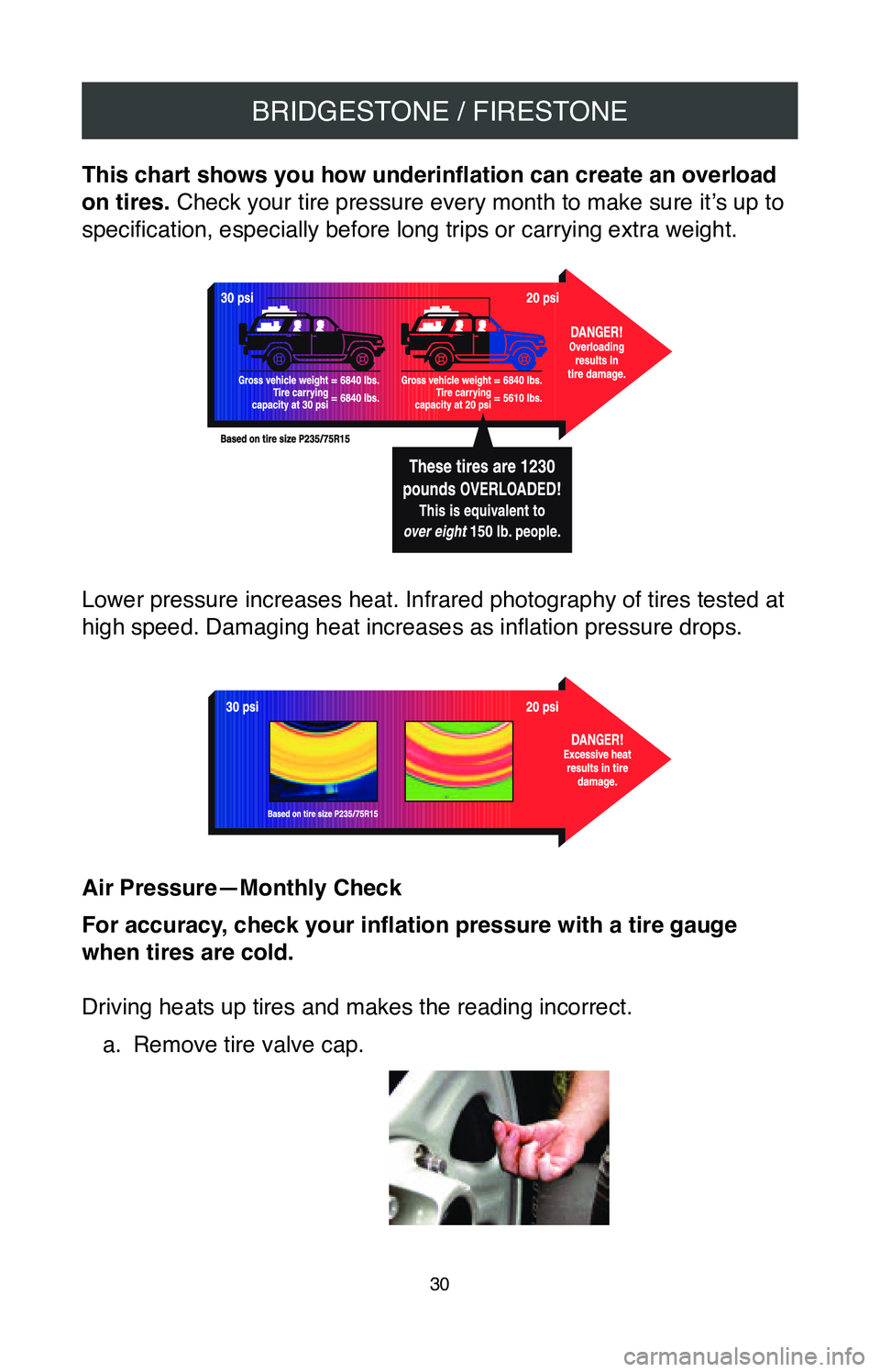
BRIDGESTONE / FIRESTONE
30
This chart shows you how underinflation can create an overload
on tires. Check your tire pressure every month to make sure it’s up to
specification, especially before long trips or carrying extra weight.
Lower pressure increases heat. Infrared photography of tires tested at
high speed. Damaging heat increases as inflation pressure drops.
Air Pressure—Monthly Check
For accuracy, check your inflation pressure with a tire gauge
when tires are cold.
Driving heats up tires and makes the reading incorrect.a.
Remove tire valve cap.
Page 36 of 260
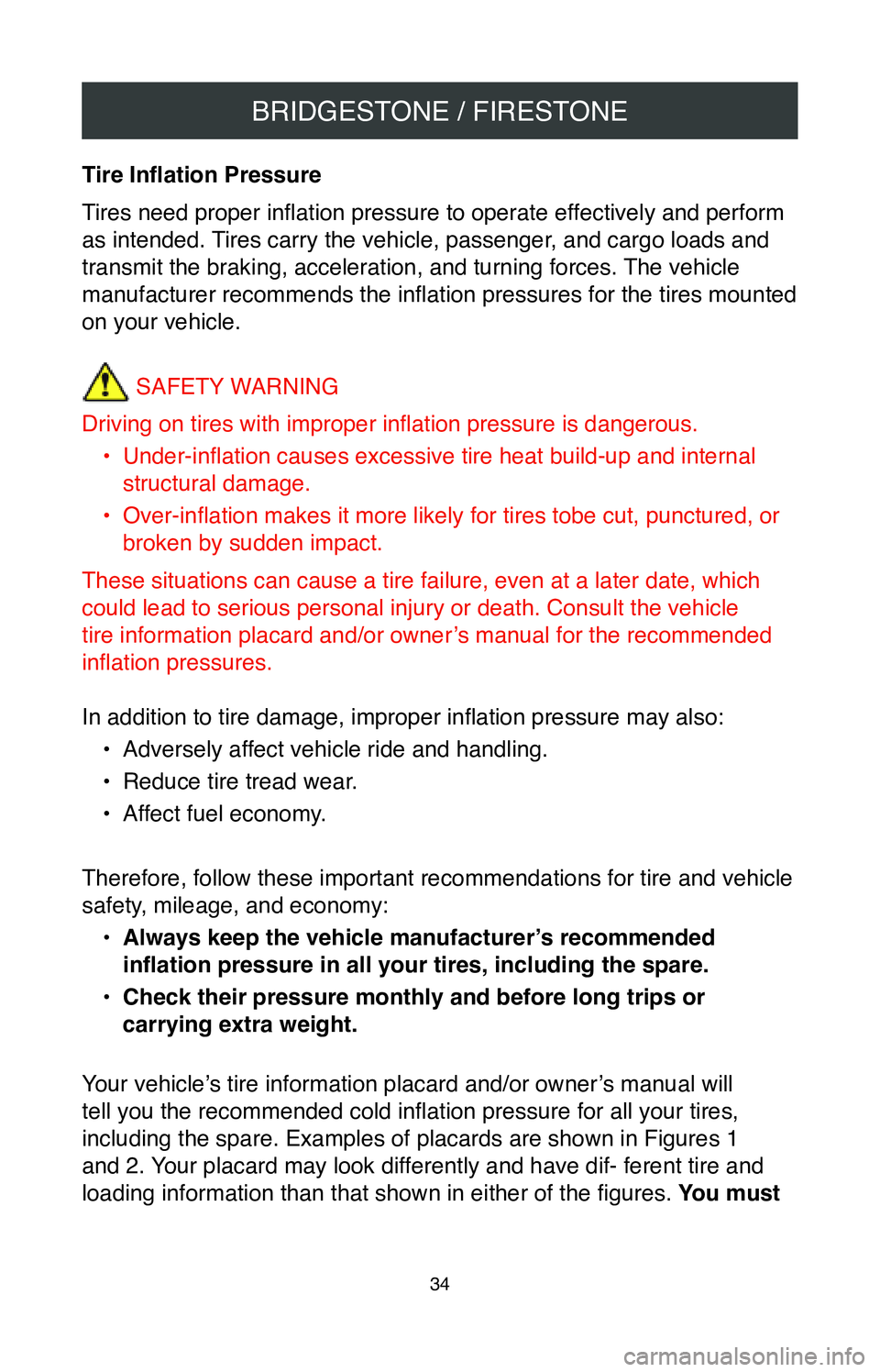
BRIDGESTONE / FIRESTONE
34
Tire Inflation Pressure
Tires need proper inflation pressure to operate effectively and perform
as intended. Tires carry the vehicle, passenger, and cargo loads and
transmit the braking, acceleration, and turning forces. The vehicle
manufacturer recommends the inflation pressures for the tires mounted
on your vehicle.SAFETY WARNING
Driving on tires with improper inflation pressure is dangerous. •
Under-inflation causes excessive tire heat build-up and internal
structural damage.
•
Over-inflation makes it more likely for tires tobe cut, punctured, or
broken by sudden impact.
These situations can cause a tire failure, even at a later date, which
could lead to serious personal injury or death. Consult the vehicle
tire information placard and/or owner’s manual for the recommended
inflation pressures.
In addition to tire damage, improper inflation pressure may also: •
Adversely affect vehicle ride and handling.
•
Reduce tire tread wear.
•
Affect fuel economy.
Therefore, follow these important recommendations for tire and vehicle
safety, mileage, and economy: •
Always keep the vehicle manufacturer’s recommended
inflation pressure in all your tires, including the spare.
•
Check their pressure monthly and before long trips or
carrying extra weight.
Your vehicle’s tire information placard and/or owner’s manual will
tell you the recommended cold inflation pressure for all your tires,
including the spare. Examples of placards are shown in Figures 1
and 2. Your placard may look differently and have dif- ferent tire and
loading information than that shown in either of the figures. You must
Page 38 of 260
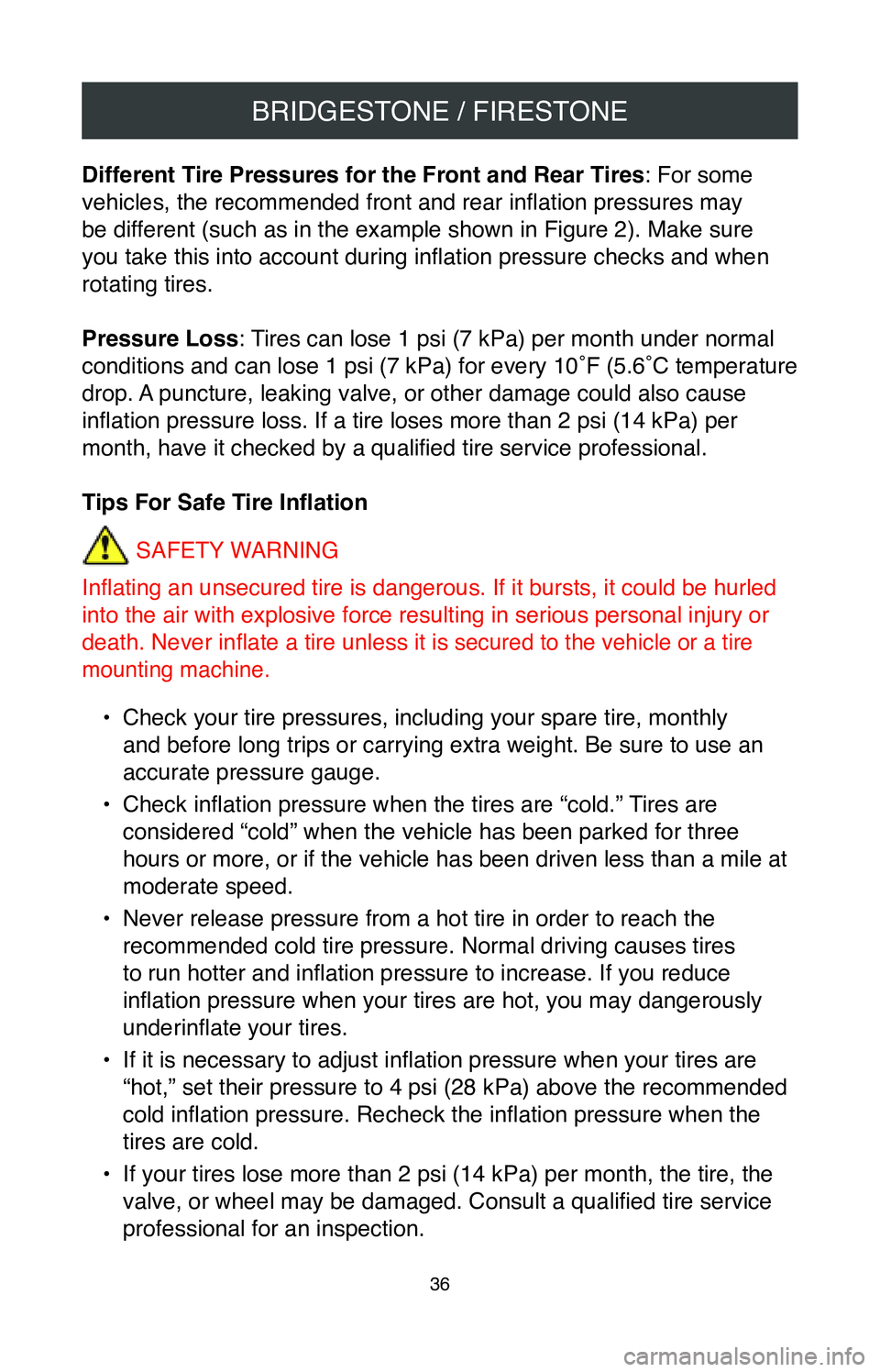
BRIDGESTONE / FIRESTONE
36
Different Tire Pressures for the Front and Rear Tires: For some
vehicles, the recommended front and rear inflation pressures may
be different (such as in the example shown in Figure 2). Make sure
you take this into account during inflation pressure checks and when
rotating tires.
Pressure Loss: Tires can lose 1 psi (7 kPa) per month under normal
conditions and can lose 1 psi (7 kPa) for every 10˚F (5.6˚C temperature
drop. A puncture, leaking valve, or other damage could also cause
inflation pressure loss. If a tire loses more than 2 psi (14 kPa) per
month, have it checked by a qualified tire service professional.
Tips For Safe Tire Inflation
SAFETY WARNING
Inflating an unsecured tire is dangerous. If it bursts, it could be hurled
into the air with explosive force resulting in serious personal injury or
death. Never inflate a tire unless it is
secured to the vehicle or a tire
mounting machine.
• Check your tire pressures, including your spare tire, monthly
and before long trips or carrying extra weight. Be sure to use an
accurate pressure gauge.
•
Check inflation pressure when the tires are “cold.” Tires are
considered “cold” when the vehicle has been parked for three
hours or more, or if the vehicle has been driven less than a mile at
moderate speed.
•
Never release pressure from a hot tire in order to reach the
recommended cold tire pressure. Normal driving causes tires
to run hotter and inflation pressure to increase. If you reduce
inflation pressure when your tires are hot, you may dangerously
underinflate your tires.
•
If it is necessary to adjust inflation pressure when your tires are
“hot,” set their pressure to 4 psi (28 kPa) above the recommended
cold inflation pressure. Recheck the inflation pressure when the
tires are cold.
•
If your tires lose more than 2 psi (14 kPa) per month, the tire, the
valve, or wheel may be damaged. Consult a qualified tire service
professional for an inspection.
Page 39 of 260

BRIDGESTONE / FIRESTONE
37
• Use valve caps to keep the valves clear of debris and to help
guard against inflation pressure loss.
Tips For Safe Loading SAFETY WARNING
Driving your vehicle in an overloaded condition is dangerous
Overloading causes excessive tire heat build-up and internal structural
damage. This can cause a tire failure, even at a later date, which
could lead to serious personal injury or death. Consult the vehicle tire
information placard, certification label, and owner’s manual for the
recommended vehicle load limits and loading recommendations.
•
Always keep the vehicle manufacturer’s recommended inflation
pressure in all your tires, including the spare. Check their pressure
monthly and before long trips or carrying extra weight.
•
Never exceed the maximum load rating stamped on the sidewall of
your tire.
•
Never exceed the gross vehicle weight rating (GVWR) or front/rear
gross axle weight ratings (GAWR) of your vehicle.
•
Consult your vehicle owner’s manual for load recommendations
and special instructions (such as for trailer/towing and snow
plow installations).
Tire Damage, Inspection and Service Life
Evaluation and maintenance of your tires is important to their
performance and the service they provide to you. Over time and/
or through use, the condition of a tire can change from exposure to
everyday road conditions, the environment, damaging events such as
punctures, and other external factors.
SAFETY WARNING
Driving on damaged tires is dangerous. A damaged tire can suddenly
fail causing serious
personal injury or death. Have your tires regularly
inspected by a qualified tire service professional.
Page 54 of 260
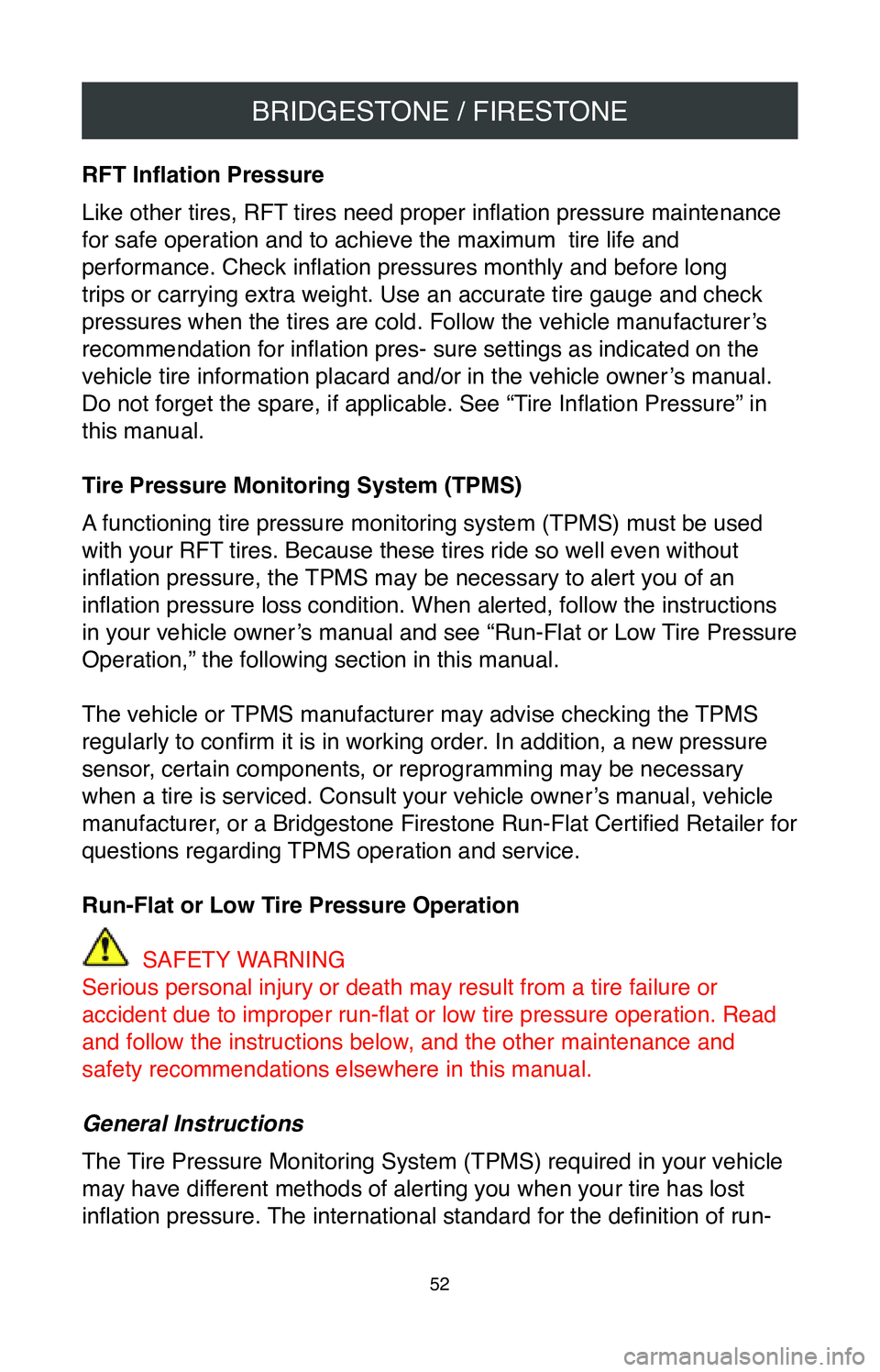
BRIDGESTONE / FIRESTONE
52
RFT Inflation Pressure
Like other tires, RFT tires need proper inflation pressure maintenance
for safe operation and to achieve the maximum tire life and
performance. Check inflation pressures monthly and before long
trips or carrying extra weight. Use an accurate tire gauge and check
pressures when the tires are cold. Follow the vehicle manufacturer’s
recommendation for inflation pres- sure settings as indicated on the
vehicle tire information placard and/or in the vehicle owner’s manual.
Do not forget the spare, if applicable. See “Tire Inflation Pressure” in
this manual.
Tire Pressure Monitoring System (TPMS)
A functioning tire pressure monitoring system (TPMS) must be used
with your RFT tires. Because these tires ride so well even without
inflation pressure, the TPMS may be necessary to alert you of an
inflation pressure loss condition. When alerted, follow the instructions
in your vehicle owner’s manual and see “Run-Flat or Low Tire Pressure
Operation,” the following section in this manual.
The vehicle or TPMS manufacturer may advise checking the TPMS
regularly to confirm it is in working order. In addition, a new pressure
sensor, certain components, or reprogramming may be necessary
when a tire is serviced. Consult your vehicle owner’s manual, vehicle
manufacturer, or a Bridgestone Firestone Run-Flat Certified Retailer for
questions regarding TPMS operation and service.
Run-Flat or Low Tire Pressure Operation
SAFETY WARNING
Serious personal injury or death may result from a tire failure or
accident due to improper run-flat or low tire pressure operation. Read
and follow the instructions below, and the other maintenance and
safety recommendations elsewhere in this manual.
General Instructions
The Tire Pressure Monitoring System (TPMS) required in your vehicle
may have different methods of alerting you when your tire has lost
inflation pressure. The international standard for the definition of run-
Page 76 of 260
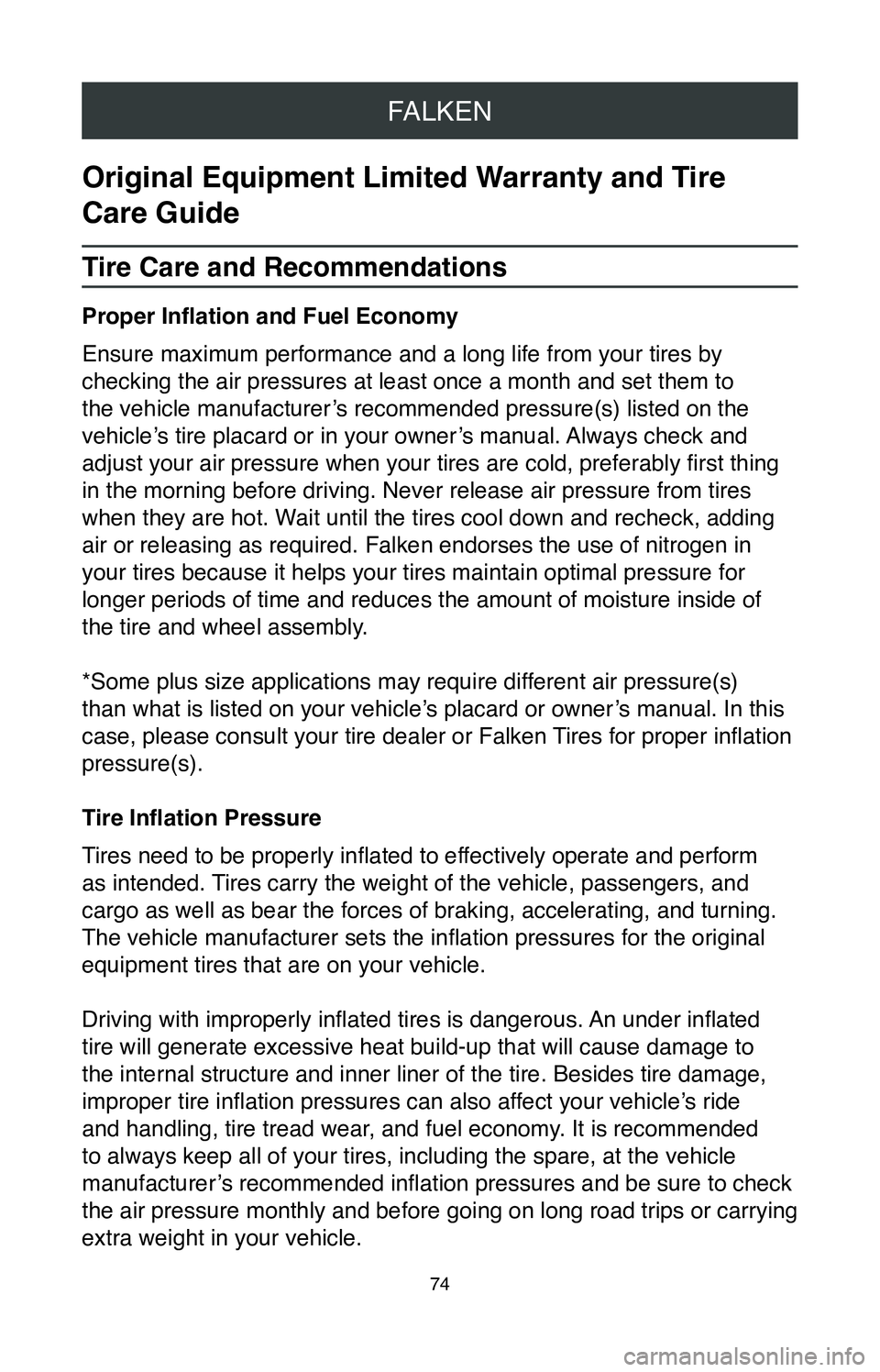
FALKEN
74
Original Equipment Limited Warranty and Tire
Care Guide
Tire Care and Recommendations
Proper Inflation and Fuel Economy
Ensure maximum performance and a long life from your tires by
checking the air pressures at least once a month and set them to
the vehicle manufacturer’s recommended pressure(s) listed on the
vehicle’s tire placard or in your owner’s manual. Always check and
adjust your air pressure when your tires are cold, preferably first thing
in the morning before driving. Never release air pressure from tires
when they are hot. Wait until the tires cool down and recheck, adding
air or releasing as required. Falken endorses the use of nitrogen in
your tires because it helps your tires maintain optimal pressure for
longer periods of time and reduces the amount of moisture inside of
the tire and wheel assembly.
*Some plus size applications may require different air pressure(s)
than what is listed on your vehicle’s placard or owner’s manual. In this
case, please consult your tire dealer or Falken Tires for proper inflation
pressure(s).
Tire Inflation Pressure
Tires need to be properly inflated to effectively operate and perform
as intended. Tires carry the weight of the vehicle, passengers, and
cargo as well as bear the forces of braking, accelerating, and turning. \
The vehicle manufacturer sets the inflation pressures for the original
equipment tires that are on your vehicle.
Driving with improperly inflated tires is dangerous. An under inflated
tire will generate excessive heat build-up that will cause damage to
the internal structure and inner liner of the tire. Besides tire damage,\
improper tire inflation pressures can also affect your vehicle’s ride
and handling, tire tread wear, and fuel economy. It is recommended
to always keep all of your tires, including the spare, at the vehicle
manufacturer’s recommended inflation pressures and be sure to check
the air pressure monthly and before going on long road trips or carrying
extra weight in your vehicle.
Page 108 of 260
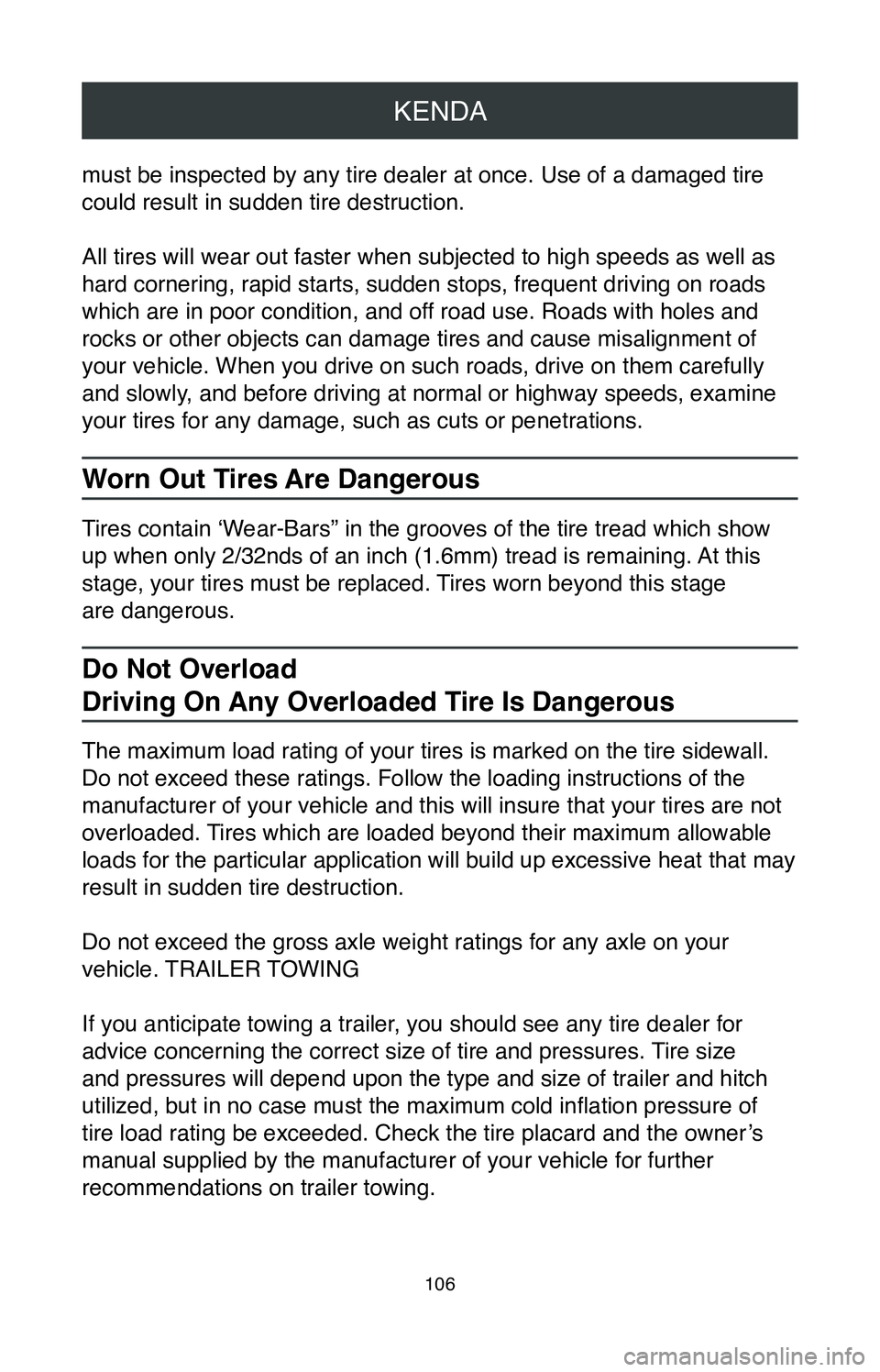
KENDA
106
must be inspected by any tire dealer at once. Use of a damaged tire
could result in sudden tire destruction.
All tires will wear out faster when subjected to high speeds as well as
hard cornering, rapid starts, sudden stops, frequent driving on roads
which are in poor condition, and off road use. Roads with holes and
rocks or other objects can damage tires and cause misalignment of
your vehicle. When you drive on such roads, drive on them carefully
and slowly, and before driving at normal or highway speeds, examine
your tires for any damage, such as cuts or penetrations.
Worn Out Tires Are Dangerous
Tires contain ‘Wear-Bars” in the grooves of the tire tread which show
up when only 2/32nds of an inch (1.6mm) tread is remaining. At this
stage, your tires must be replaced. Tires worn beyond this stage
are dangerous.
Do Not Overload
Driving On Any Overloaded Tire Is Dangerous
The maximum load rating of your tires is marked on the tire sidewall.
Do not exceed these ratings. Follow the loading instructions of the
manufacturer of your vehicle and this will insure that your tires are no\
t
overloaded. Tires which are loaded beyond their maximum allowable
loads for the particular application will build up excessive heat that m\
ay
result in sudden tire destruction.
Do not exceed the gross axle weight ratings for any axle on your
vehicle. TRAILER TOWING
If you anticipate towing a trailer, you should see any tire dealer for
advice concerning the correct size of tire and pressures. Tire size
and pressures will depend upon the type and size of trailer and hitch
utilized, but in no case must the maximum cold inflation pressure of
tire load rating be exceeded. Check the tire placard and the owner’s
manual supplied by the manufacturer of your vehicle for further
recommendations on trailer towing.